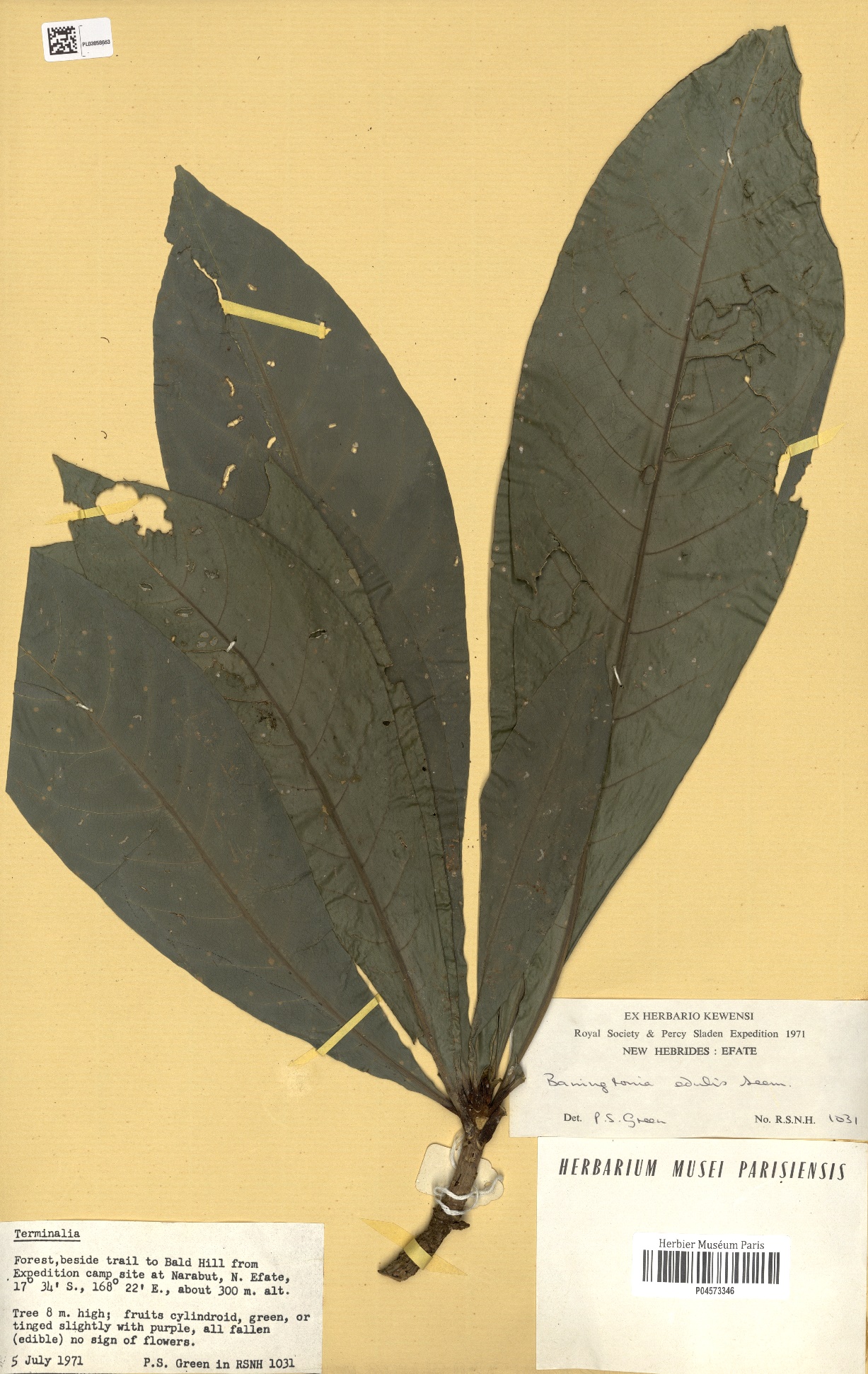Barringtonia edulis
Barringtonia edulis
The Cut nut or pao nut, boxfruit tree, heart tree, yum-yum tree (Barringtonia edulis Seem., 1866) is an arboreal species belonging to the Lecythidaceae family.
Systematics –
From a systematic point of view it belongs to:
Eukaryota domain,
Kingdom Plantae,
Subkingdom Tracheobionta,
Magnoliophyta division,
Class Magnoliopsida,
Subclass Dilleniidae,
Order Lecythidales,
Lecythidaceae family,
Genus Barringtonia,
B. edulis species.
The terms are synonyms:
– Butonica edulis (Seem.) Miers;
– Huttum edule (Seem.) Britten.
Etymology –
The term Barringtonia was attributed in honor of the English lawyer, antiquarian and naturalist Daines Barrington (1727-1800).
The specific epithet edulis comes from the Latin édo mangia: edible, in reference to the seeds.
Geographic Distribution and Habitat –
Barringtonia edulis is a plant native to the Pacific Southwest region, found in Fiji and Vanuatu.
Its natural habitat is that of moist forests near the coast, at altitudes up to 400 meters above sea level.
Description –
Barringtonia edulis is a sparsely branched evergreen tree that grows to a height of about 18 m.
It has a trunk with a diameter of up to 40 cm and smooth, greyish-brown bark. The leaves are large, glossy green and grow in clusters at the ends of the branches. They are carried by short petioles and have dimensions of up to 45 cm in length and 18 cm in breadth. The leaf blades are simple, oblong-elliptical and entire, with slightly wavy margins, prominent veins and acute apices.
The inflorescence is a hanging terminal raceme up to 80 cm long. The central rachis bears a whorl of small tubular, hermaphroditic, closely spaced flowers with inverted reddish-brown globular calyxes, with two to four red lobes, four square white petals, a protruding head of stamens and a single, long style.
The fruits are oblong berries with persistent calyxes, up to 10 cm long, with densely ruffled short hairs, greyish-green in colour, turning reddish or purplish as they ripen.
Cultivation –
Barringtonia edulis is a tree that is harvested from the wild for local use as food, medicine and a source of wood.
The tree is sometimes grown in home gardens and around villages and footpaths; it is generally semi-cultivated when the forest is cleared.
This plant is particularly ornamental due to the presence of the large and glossy leaves and the long and showy inflorescences; it can be cultivated exclusively in the tropical and humid subtropical climate zones in full sun or slight shade, in particular when young, on soils rich in organic substance kept humid.
Reproduction occurs by seed; this is placed in an organic substratum, with addition of sand or perlite for a 30% to improve the drainage, kept humid at the temperature of 22-24 °C.
Customs and Traditions –
Barringtonia edulis is a plant that in the Fiji Islands is known by the names of vutu (a term also used for Barringtonia asiatica), vutukala, kutuvala and vana. Other names by which it is known are: box-fruit tree, cut nut, heart tree, pan nut, pao nut, yum yum tree (English); ship (bislama); nuez de Fiji (Spanish).
The seeds of this plant represent the edible part of the fruit; they are of a pleasant taste, and eaten raw, boiled or roasted.
The seeds are sold in local markets and are believed to have significant commercial potential for a wider market.
In traditional medicine, the bark and leaves are used for various pathologies.
The bark is used, in particular, in the treatment of stomach disorders and gonorrhea.
In the area of origin it is claimed that a strong tea, obtained from the bark, induces abortion and definitive sterility.
Among other uses, the wood is used which is used in construction, for coverings, paddles, tools and objects of common use and also locally as a fast-burning fuel.
The wood is light, with a density of around 480 kg/m3.
From an ecological point of view, the flowers of Barringtonia edulis are pollinated by moths and bats. The tree is home to several species of fruit flies, including the eastern fruit fly (Bactrocera dorsalis), the Pacific fruit fly (Bactrocera xanthodes), and the Fijian fruit fly (Bactrocera passiflorae).
Method of Preparation –
Barringtonia edulis is a plant whose seeds are eaten; these have a pleasant flavor (reminiscent of peanuts) and are eaten raw, boiled or roasted.
The fruits can also be eaten, raw or cooked, but are said to be tasteless.
The bark is used in traditional medicine, to treat stomach problems and gonorrhea and to induce abortion.
The wood is light and produces fast burning firewood.
The timber is used for light construction, roofing and for making canoe paddles.
Guido Bissanti
Sources
– Acta Plantarum – Flora of the Italian Regions.
– Wikipedia, the free encyclopedia.
– GBIF, the Global Biodiversity Information Facility.
– Useful Tropical Plants Database.
– Conti F., Abbate G., Alessandrini A., Blasi C. (ed.), 2005. An annotated checklist of the Italian vascular flora, Palombi Editore.
– Pignatti S., 1982. Flora of Italy, Edagricole, Bologna.
– Treben M., 2000. Health from the Lord’s Pharmacy, Advice and experiences with medicinal herbs, Ennsthaler Editore.
Photo source:
– https://bs.plantnet.org/image/o/894693a54e94d54228149e03f9e11c7661005b1e
– http://mediaphoto.mnhn.fr/media/1441380010948ss0rMrYjdWfZilGK
Attention: The pharmaceutical applications and alimurgical uses are indicated for informational purposes only, they do not in any way represent a medical prescription; we therefore decline all responsibility for their use for curative, aesthetic or food purposes.


